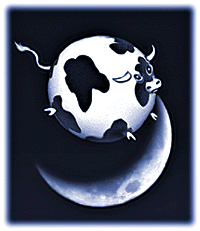
The spherical cow is a humorous metaphor for highly simplified scientific models of complex phenomena.[1][2][3][4] Originating in theoretical physics, the metaphor refers to some scientific tendencies to develop toy models that reduce a problem to the simplest form imaginable, making calculations more feasible, even if the simplification hinders the model's application to reality.
History
[edit]The phrase comes from a joke that spoofs the simplifying assumptions sometimes used in theoretical physics.[5]
Milk production at a dairy farm was low, so the farmer wrote to the local university, asking for help from academia. A multidisciplinary team of professors was assembled, headed by a theoretical physicist, and two weeks of intensive on-site investigation took place. The scholars then returned to the university, notebooks crammed with data, where the task of writing the report was left to the team leader. Shortly thereafter the physicist returned to the farm, saying to the farmer, "I have the solution, but it works only in the case of spherical cows in a vacuum."
John Harte, who received his Ph.D. from the University of Wisconsin in 1965,[6] reported that he first heard the joke as a graduate student.[7] One of the earliest published references is in a 1970 article by Arthur O. Williams Jr. of Brown University, who described it as "a professional joke that circulated among scientists a few years ago".[8]
The story is told in many variants,[9] including a joke about a physicist who said he could predict the winner of any race provided it involved spherical horses moving through a vacuum.[10][11] A 1973 letter to the editor in the journal Science describes the "famous story" about a physicist whose solution to a poultry farm's egg-production problems began with "Postulate a spherical chicken".[12]
Cultural references
[edit]

The concept is familiar enough that the phrase is sometimes used as shorthand for the entire issue of proper modeling. For example, Consider a Spherical Cow is a 1985 book about problem solving using simplified models.[7] A 2015 paper on the systemic errors introduced by simplifying assumptions about spherical symmetries in galactic dark-matter haloes was titled "Milking the spherical cow – on aspherical dynamics in spherical coordinates".[13]
References to the joke appear even outside the field of scientific modeling. "Spherical Cow" was chosen as the code name for the Fedora 18 Linux distribution.[14] In the sitcom The Big Bang Theory, a joke is told by Dr. Leonard Hofstadter with the punchline mentioning "spherical chickens in a vacuum", in "The Cooper-Hofstadter Polarization" episode.[15] In the space gravity simulator educational video game Universe Sandbox, a spherical cow was added as a user-placeable object in March 2023.[16]
See also
[edit]- Assume a can opener, a joke about invalid assumptions in economics
- Amorphous globosus, a rare and fatal birth defect in cattle, producing a ball of underdeveloped tissue
- Fermi problem, efforts to produce very broad estimates
- Homo economicus, a hypothetical rational person
- Naïve physics, also called folk physics
- Schwarzschild metric, an exact solution of the Einstein field equations assuming a uniform spherical symmetric nonrotating uncharged mass in a vacuum
References
[edit]- ^ Shelton, Robin; Cliffe, J. Allie. "Spherical Cows". Supernova Remnant Group. NASA Goddard Space Flight Center. Archived from the original on 9 October 1999.
- ^ Kaiser, David (2014-04-25). "The Sacred, Spherical Cows of Physics". Nautilus Quarterly.
- ^ Carroll, Sean. "How spherical-cow philosophy makes hard physics problems easy". New Scientist. Retrieved 2023-04-27.
- ^ Allain, Rhett. "What is up with the spherical cow?". Wired. ISSN 1059-1028. Retrieved 2023-04-27.
- ^ Lee, Timothy B. (September 4, 2013). "The Coase Theorem is widely cited in economics. Ronald Coase hated it". The Washington Post.
- ^ "John Harte". ESPM UC Berkeley Rausser College of Natural Resources. Retrieved April 4, 2018.
- ^ a b Harte, John (1985). "Preface". Consider a Spherical Cow: A Course in Environmental Problem Solving. Los Altos: William Kaufmann. p. xiii. ISBN 0-86576-086-1.
- ^ Williams Jr., A. O. (1970). "Normal-mode Methods in Propagation of Underwater Sound". In Stephens, R. W. B. (ed.). Underwater Acoustics. Wiley-Interscience. p. 25. ISBN 0471822043.
- ^ Kirkman, T. W. (1996). "Spherical Cow: A Simple Model". Statistics to Use. Retrieved 2007-02-19.
- ^ Mager, Birgit; Evenson, Shelley (1 February 2008). "Art of Service: Drawing the Arts to inform Service Design and Specification". In Hefley, Bill; Murphy, Wendy (eds.). Service science, management and engineering: education for the 21st century. Springer. p. 80. doi:10.1007/978-0-387-76578-5_12. ISBN 978-0-387-76577-8. Retrieved 28 September 2011.
- ^ Birattari, Mauro (15 April 2009). "Some Considerations on the Experimental Methodology". Tuning Metaheuristics: A Machine Learning Perspective. Studies in Computational Intelligence. Vol. 197. Springer. pp. 183–184. doi:10.1007/978-3-642-00483-4. ISBN 978-3-642-00482-7. Retrieved 1 September 2012.
- ^ Stellman, Steven D. (1973-12-28). "A Spherical Chicken". Science. 182 (4119): 1296. doi:10.1126/science.182.4119.1296.c. PMID 17733092. S2CID 29103654. Retrieved 18 Feb 2017.
- ^ Pontzen, Andrew; Read, Justin I.; Teyssier, Romain; Governato, Fabio; Gualandris, Alessia; Roth, Nina; Devriendt, Julien (1 August 2015). "Milking the spherical cow – on aspherical dynamics in spherical coordinates". Monthly Notices of the Royal Astronomical Society. 451 (2): 1366–1379. arXiv:1502.07356. doi:10.1093/mnras/stv1032. Retrieved 6 December 2022.
- ^ Larabel, Michael (2012-05-01). "Fedora 18 Is Codenamed The Spherical Cow". Phoronix. Retrieved 2023-06-06.
- ^ Huva, Amy. "When nerds go viral". Earth Matters. The Vancouver Observer. Archived from the original on 2019-12-05.
- ^ "A Comet, an Asteroid, and a Planet Walk into the Solar System | Update 32.2". Universe Sandbox. 2023-03-23. Retrieved 2023-03-27.
External links
[edit]- NASA:Exploration of the Universe Division – Supernova models as spherical cows
- Hubble Heritage Gallery Page: related history from Space Telescope Institute